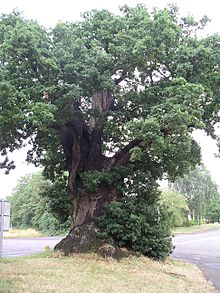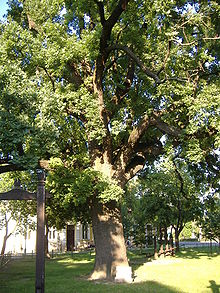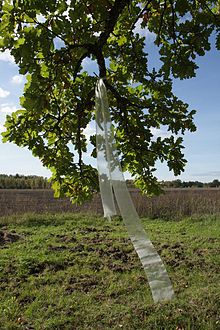- Quercus robur
-
Quercus robur
Pedunculate Oak—English oak
Leaves and acorns (note the long acorn stalks). Conservation status Scientific classification Kingdom: Plantae (unranked): Angiosperms (unranked): Eudicots (unranked): Rosids Order: Fagales Family: Fagaceae Genus: Quercus Section: Quercus Species: Q. robur Binomial name Quercus robur
L.Quercus robur (sometimes considered Q. pedunculata or "Q. robur") is commonly known as the Pedunculate Oak or English oak. It is native to most of Europe, and to Anatolia to the Caucasus, and also to parts of North Africa.
Contents
Taxonomy


Ancient pedunculate oaks at Wistman's Wood in Devon, England. Q. robur (Latin quercus, "oak" + robur "strength, hard timber") is the type species of the genus (the species by which the oak genus Quercus is defined), and a member of the white oak section Quercus section Quercus. The populations in Italy, southeast Europe, and Asia Minor and the Caucasus are sometimes treated as separate species, Q. brutia Tenore, Q. pedunculiflora K. Koch and Q. haas Kotschy respectively.
A close relative is the Sessile Oak (Q. petraea), which shares much of its range. Q. robur is distinguished from this species by its leaves having only a very short stalk 3–8 mm long, and by its pedunculate (stalked) acorns. The two often hybridise in the wild, the hybrid being known as Quercus × rosacea.
Description
Quercus robur is a large deciduous tree 25–35 m (80–115 ') tall (exceptionally to 50 m (160 '))[citation needed], and thick, with circumference of grand oaks from 4 m (13') to exceptional 12m (40'). Majesty Oak with the circumference of 12,2 m (40') is the thickest tree in Great Britain, but Kaive Oak in Latvia with the circumference of 10,2 m (33,5') is the thickest tree in Northern Europe. Q. robur has lobed and nearly sessile (very short-stalked) leaves 7–14 cm long. Flowering takes place in mid spring, and their fruit, called acorns, ripen by the following autumn. The acorns are 2–2.5 cm long, pedunculate (having a peduncle or acorn-stalk, 3–7 cm long) with one to four acorns on each peduncle.
It is a long-lived tree, with a large widespreading crown of rugged branches. While it may naturally live to an age of a few centuries, many of the oldest trees are pollarded or coppiced, both pruning techniques that extend the tree's potential lifespan, if not its health. A specimen of notable longevity is the Stelmužė Oak in Lithuania which is believed to be approximately 1,500 years old, possibly making it the oldest oak in Europe; another specimen, called the 'Kongeegen' ('Kings Oak'), estimated to be about 1,200 years old, grows in Jaegerspris, Denmark. Yet another can be found in Kvilleken, Sweden, that is over 1,000 years old and 14 meters around.[1] Of maiden (not pollarded) specimens, one of the oldest is the great oak of Ivenack, Germany. Tree-ring research of this tree and other oaks nearby gives an estimated age of 700 to 800 years old. Also the Bowthorpe Oak in Lincolnshire, England is estimated to be 1,000 years old making it the oldest in the UK, although there is Knightwood Oak in the New Forest which is also said to be as old. Highest density of the Q. robur grand oaks with a circumference 4 meters and more is in Latvia.
Ecological importance
Within its native range Q. robur is valued for its importance to insects and other wildlife. Numerous insects live on the leaves, buds, and in the acorns. Q.robur supports the highest biodiversity of insect herbivores of any British plant (>400 spp). The acorns form a valuable food resource for several small mammals and some birds, notably Eurasian Jays Garrulus glandarius. Jays were overwhelmingly the primary propagators[2] of oaks before humans began planting them commercially, because of their habit of taking acorns from the umbra of its parent tree and burying it undamaged elsewhere. Mammals, notably squirrels who tend to hoard acorns and other nuts most often leave them too abused to grow in the action of moving or storing them.
Commercial forestry
Quercus robur' is planted for forestry, and produces a long-lasting and durable heartwood, much in demand for interior and furniture work. The wood of Q. robur is identified by a close examination of a cross-section perpendicular to fibres. The wood is characterised by its distinct (often wide) dark and light brown growth rings. The earlywood displays a vast number of large vessels (~0.5 mm diameter). There are rays of thin (~0.1 mm) yellow or light brown lines running across the growth rings. The timber is around 720 kg per cubic meter in density.[3]
Cultivation
Quercus robur is cultivated as an ornamental tree in the temperate regions of most continents. A number of cultivars are grown in gardens and parks and in arboreta and botanical gardens. The most common cultivar is Quercus robur 'Fastigiata', and is the exception among Q. robur cultivars which are generally smaller than the standard tree, growing to between 10–15 m and exhibit unusual leaf or crown shape characteristics.
- In Australia
English Oak is one of the most common park trees in south-eastern Australia, noted for its vigorous, luxuriant growth. In Australia, it grows very quickly to a tree of 20m tall by up to 20m broad, with a low-branching canopy. Its trunk and secondary branches are very thick and solid and covered with deep-fissured blackish-grey bark.[4]
The largest example in Australia is in Donnybrook, Western Australia.[5]
Cultivars
- Quercus robur 'Fastigiata' ("Cypress Oak"), probably the most common cultivated form, it grows to a large imposing tree with a narrow columnar habit. The fastigiate oak was originally propagated from an upright tree that was found in central Europe.
- Quercus robur 'Concordia' ("Golden Oak"), a small very slow-growing tree, eventually reaching 10 m, with bright golden-yellow leaves throughout spring and summer. It was originally raised in Van Geert's nursery at Ghent in 1843.
- Quercus robur 'Pendula' ("Weeping Oak"), a small to medium sized tree with pendulous branches, reaching up to 15 m.
- Quercus robur 'Purpurea' is another cultivar growing to 10 m, but with purple coloured leaves.
- Quercus robur 'Filicifolia' ("Cut-leaved Oak") is a cultivar where the leaf is pinnately divided into fine forward pointing segments.
Hybrids
Along with the naturally occurring Q. × rosacea, several hybrids with other white oak species have also been produced in cultivation, including Turner's Oak Q. × turnerii, Heritage Oak Q. × macdanielli, and Two Worlds Oak Q. × bimundorum, the latter two developed by nurseries in the United States.
- Q. × bimundorum (Q. alba × Q. robur) (Two Worlds Oak)
- Q. × macdanielli (Q. macrocarpa × Q. robur) (Heritage Oak)
- Q. × rosacea Bechst. (Q. petraea x Q. robur), a hybrid of the Sessile Oak and English Oak. It is usually of intermediate character between its parents, however it does occasionally exhibit more pronounced characteristics of one or the other parent.
- Q. × turnerii Willd. (Q. ilex × Q. robur) (Turner's Oak), a semi-evergreen tree of small to medium size with a rounded crown; it was originally raised at Mr. Turner's nursery, Essex, UK, in 1783. An early specimen is at the Royal Botanic Gardens, Kew.[6]
- Q. × wareii (Q. robur fastigiata x Q. bicolor), a hybrid between Upright English Oak and the Swamp White Oak. The Selections within this hybrid include the (Regal Prince) 'Long'[1] cultivar and the (Kindred Spirit) 'Nadler' cultivar see Kindred Spirit Hybrid Oak with photos...International Oak Society Link
Diseases
- Acute oak decline
- Sudden oak death
Symbolism
- England
In England, the English oak has assumed the status of a national emblem. This has its origins in the oak tree at Boscobel House, where the future King Charles II hid from his Parliamentarian pursuers in 1650 during the English Civil War; the tree has since been known as the Royal Oak. This event was celebrated nationally on 29 May as Oak Apple Day, which is continued to this day in some communities.[7] ‘The Royal Oak’ is the third most popular pub name in Britain (541 in 2007)[8] and has been the name of eight major Royal Navy warships. The naval associations are strengthened by the fact that oak was the main construction material for sailing warships. The Royal Navy was often described as ‘The Wooden Walls of Old England’[9] (a paraphrase of the Delphic Oracle) and the Navy’s official quick march is ‘Heart of Oak’. Furthermore, the oak is the most common woodland tree in England.[10] An oak tree has been depicted on the reverse of the pound coin (the 1987 issue) and a sprig of oak leaves and acorns is the emblem of the National Trust.
- Ireland
In Ireland, at Birr Castle, an example, over 400 years old has a girth of 6.5 m. It is known as the Carroll Oak, referring to the local Chieftains, Ely O'Carroll who ruled prior to Norman occupation.[11]
- Romania
The Romanian Rugby Union side are also known as "The Oaks."
- Croatia
Oak leaves with acorns are depicted on the reverse of the Croatian 5 lipa coin, minted since 1993.[12]
- Latvia
Love for trees is Latvian identity. Like an ancient legend, like presumable truth, old books tell stories about the time when Balts tribes came to Latvia and became Latvians. At those times all Zemgale, Kurzeme and partly Vidzeme region were covered by endless virgin oak forests. Home of Balts good Pērkons, tree of the world – axes that connects past, present and future. Oaks are most sacred trees for Latvians, Livs, Lithuanians and all other Balt tribes and nations from Oka and Volga rivers in east to Odera and Elba rivers in west.
Latvian collections of folk traditions and beliefs tell of numerous cases, when the sacred trees’ choppers, burners or branch breakers became ill and died, or became blind, even became mad. This is the recognition, that sacred tree destruction can not go unpunished. In Latvian folk songs old oak giants are spoken to with great respect and affection in caressing words. "Man like an oak", "Tall like an oak", "Strong like an oak" – those epithets have ever been in the minds of Latvians. In Latvian folk songs and tales oak is symbol of young man, but lime-tree symbolizes young woman. In the largest Latvian midsummer eve celebration Jāņi, people make oak wreaths, decorate houses, horse cats, and cars with the oak branches. Nowadays oak branches decorate coat of arms of Latvia, Lats banknotes, logos of companies and organizations. Oak is used in names, surnames and place names. Oak wreaths are used as decoration not just in midsummer eve Līgo, but also in family celebrations, national celebrations, the song and dance festivals, openings of buildings, bridges and monuments. Couple have wedding ceremonies under the oaks. Oak leaf is symbol of specially protected nature territories in Latvia.
See also
References
- ^ http://www5.h.lst.se/lansfakta/natur/u_nm/rumskullaeken.htm
- ^ Page 131, Forest and Woodland Trees in Britain, John White, 1995, Oxford University Press. ISBN 0-19-854883-4
- ^ British Oak. Niche Timbers. Accessed 19-08-2009.
- ^ http://www.metrotrees.com.au/treehandbook/page-listings/quercus-robur.html
- ^ http://www.donnybrookmail.com.au/news/local/news/general/australias-biggest-oak-tree/1701700.aspx Australia's Biggest Oak Tree
- ^ http://www.rbgkew.org.uk/plants/trees/turnersoak.html
- ^ http://www.bbc.co.uk/wiltshire/moonraking/folklore_oak_apple.shtml
- ^ http://www.solihullcamra.org.uk/features_archive.htm
- ^ http://www.nmm.ac.uk/collections/explore/object.cfm?ID=MEC1924
- ^ http://www.forestry.gov.uk/pdf/frnationalinventory0001.pdf/$FILE/frnationalinventory0001.pdf
- ^ Fifty Trees of Distinction by Prof. D.A. Webb and the Earl of Ross. Booklet, published by Birr Castle Demesne, 2000.
- ^ Croatian National Bank. Kuna and Lipa, Coins of Croatia: 5 Lipa Coin. – Retrieved on 31 March 2009.
- Flora Europaea: Quercus robur
- Bean, W. J. (1976). Trees and shrubs hardy in the British Isles 8th ed., revised. John Murray.
- Rushforth, K. (1999). Trees of Britain and Europe. HarperCollins ISBN 0-00-220013-9.
- (French) Chênes: Quercus robur
External links
- Oaks from Bialowieza Forest (biggest oak cluster with the monumental sizes in Europe) {English}
- WikiSpecies entry
- Photos and location details of large English oak trees
- Latvia - the land of oaks
Categories:- IUCN Red List least concern species
- Quercus
- Trees of Europe
- Flora of Maghreb
- Flora of Great Britain
- Flora of Ireland
- Flora of Sweden
- Flora of Denmark
- Flora of Germany
- Flora of Poland
- Flora of Ukraine
- Flora of Latvia
- Flora of France
- Flora of Italy
- Flora of the United Kingdom
- Flora of Europe
- Least concern plants
- Trees of mild maritime climate
- Trees of humid continental climate
- Garden plants of Europe
- Ornamental trees
Wikimedia Foundation. 2010.





